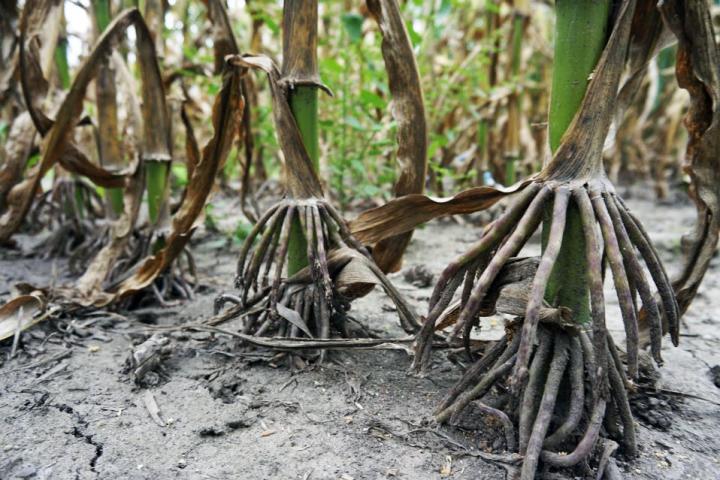
Credit: Alonso Favela, University of Illinois.
URBANA, Ill. – Corn didn’t start out as the powerhouse crop it is today. No, for most of the thousands of years it was undergoing domestication and improvement, corn grew humbly within the limits of what the environment and smallholder farmers could provide.
For its fertilizer needs, early corn made friends with nitrogen-fixing soil microbes by leaking an enticing sugary cocktail from its roots. The genetic recipe for this cocktail was handed down from parent to offspring to ensure just the right microbes came out to play.
But then the Green Revolution changed everything. Breeding tools improved dramatically, leading to faster-growing, higher-yielding hybrids than the world had ever seen. And synthetic fertilizer application became de rigueur.
That’s the moment corn left its old microbe friends behind, according to new research from the University of Illinois. And it hasn’t gone back.
“Increasing selection for aboveground traits, in a soil setting where we removed all reliance on microbial functions, degraded microbial sustainability traits. In other words, over the course of half a century, corn breeding altered its microbiome in unsustainable ways,” says Angela Kent, professor in the Department of Natural Resources and Environmental Sciences at the University of Illinois and co-author of a new study in the International Society of Microbial Ecology Journal.
Kent, along with co-authors Alonso Favela and Martin Bohn, found modern corn varieties recruit fewer “good” microbes – the ones that fix nitrogen in the soil and make it available for crops to take up – than earlier varieties. Instead, throughout the last several decades of crop improvement, corn has been increasingly recruiting “bad” microbes. These are the ones that help synthetic nitrogen fertilizers and other sources of nitrogen escape the soil, either as potent greenhouse gases or in water-soluble forms that eventually end up in the Gulf of Mexico and contribute to oxygen-starved “dead zones.”
“When I was first analyzing our results, I got a little disheartened,” says Favela, a doctoral student in the Program in Ecology, Evolution, and Conservation Biology at Illinois and first author on the study. “I was kind of sad we had such a huge effect on this plant and the whole ecosystem, and we had no idea we were even doing it. We disrupted the very root of the plant.”
To figure out how the corn microbiome has changed, Favela recreated the history of corn breeding from 1949 to 1986 by planting a chronological sequence of 20 off-patent maize lines in a greenhouse.
“We have access to expired patent-protected lines that were created during different time periods and environmental conditions. We used that understanding to travel back in time and look at how the associated microbiome was changing chronologically,” he says.
As a source of microbes, Favela inoculated the pots with soil from a local ag field that hadn’t been planted with corn or soybeans for at least two years. Once the plants were 36 days old, he sequenced the microbial DNA he collected from soil adhering to the roots.
“We characterized the microbiome and microbial functional genes related to transformations that occur in the nitrogen cycle: nitrogen fixation, nitrification, and denitrification,” he says. “We found more recently developed maize lines recruited fewer microbial groups capable of sustainable nitrogen provisioning and more microbes that contribute to nitrogen losses.”
Kent says breeding focused on aboveground traits, especially in a soil context flooded with synthetic nitrogen fertilizers, may have tweaked the sugary cocktail roots exude to attract microbes.
“Through that time period, breeders weren’t selecting for maintenance of microbial functions like nitrogen fixation and nitrogen mineralization because we had replaced all those functions with agronomic management. As we started selecting for aboveground features like yield and other traits, we were inadvertently selecting against microbial sustainability and even actively selecting for unsustainable microbiome features such as nitrification and denitrification,” she says.
Now that it’s clear something has changed, can breeders bring good microbes back in corn hybrids of the future?
Bohn, corn breeder and associate professor in the Department of Crop Sciences at Illinois, thinks it’s very possible to “rewild” the corn microbiome. For him, the answer lies in teosinte, a wild grass most people would have to squint pretty hard at to imagine as the parent of modern corn.
Like wild things everywhere, teosinte evolved in the rich context of an entire ecosystem, forming close relationships with other organisms, including soil microbes that made soil nutrients easier for the plant to access. Bohn thinks it should be possible to find teosinte genes responsible for creating the root cocktail that attracts nitrogen-fixing microbes. Then, it’s just a matter of introducing those genes into novel corn hybrids.
“I never thought we would go back to teosinte because it’s so far removed from what we want in our current agricultural landscape. But it may hold the key not only for encouraging these microbial associations; it also may help corn withstand climate change and other stresses,” Bohn says. “We actually need to go back to teosinte and start investigating what we left behind so we can bring back these important functions.”
Bringing back the ability for corn to recruit its own nitrogen fixation system would allow producers to apply less nitrogen fertilizer, leading to less nitrogen loss from the system overall.
“Farmers don’t always know how much nitrogen they will need, so, historically, they’ve dumped as much as possible onto the fields. If we bring these characteristics back into corn, it might be easier for them to start rethinking the way they manage nitrogen,” Bohn says.
Kent adds that a little change could go a long way.
“If we could reduce nitrogen losses by even 10% across the growing region of the Midwest, that would have huge consequences for the environmental conditions in the Gulf of Mexico,” she says.
###
The article, “Maize germplasm chronosequence shows crop breeding history impacts recruitment of the rhizosphere microbiome,” is published in the International Journal of Microbial Ecology Journal.
The Department of Natural Resources and Environmental Sciences and the Department of Crop Sciences are in the College of Agricultural, Consumer and Environmental Sciences at the University of Illinois.
Media Contact
Lauren Quinn
[email protected]
Original Source
https:/
Related Journal Article
http://dx.




